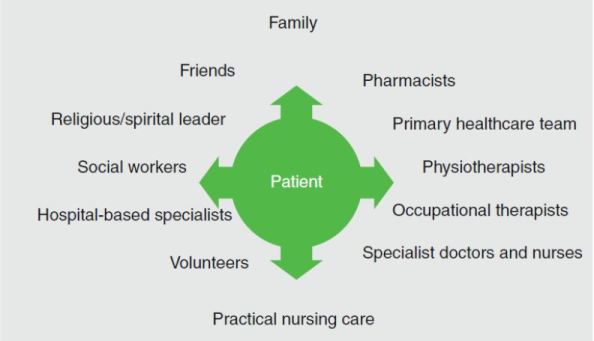While the methods of so-called “aggressive” treatment can work very well at the end of a patient’s life, sometimes it is worth it to investigate the alternatives. As patients deal with the natural progression of life and their proximity to its end, palliative care is a method that best combines treating illnesses with providing a means for patients to come to term with their care, as well. Palliative care is defined as “the active total care of patients whose disease is not responsive to curative treatment”, and palliative care “seeks to prevent, relieve, reduce or soothe the symptoms of disease or disorder without effecting a cure.” Palliative care is not meant to be used exclusively at the end of life, either. It is recommended to begin looking at palliative care options as soon as a patient has been found to have a chronic disease or illness. This type of care is aimed towards making the disease-fighting process as effective as possible. While palliative care focuses on reducing the physical suffering caused by a disease, another principal aim of palliative care is to cater to the mental and social needs of the patient. A successful palliative care team will be composed of social workers, doctors, nurses and others to create a path towards recovery that will cater towards the solving all problems in a patient’s life. The fact that palliative care offers opportunities for patients to work towards personal goals and settle conflicts with others is an important part of the care program that should not be overlooked. A sample of the various groups involved in palliative care can be found in the figure below. The purpose of palliative care is considered to be the relief of physical symptoms like pain, sleep issues, nausea, fatigue and breathing troubles, while also focusing on the quality of life of patients on a social and emotional level.
Palliative care bestows more value on working with patients to make sure they are at peace with the situation they are in, providing opportunities to have open discussions about the prognosis and development of treatment plans. An important aspect of palliative care is that if it is begun at the onset of a chronic illness, patients have the opportunity to decide what is most important to them, where they want to draw the line between fighting the illness and allowing themselves to die with dignity. Palliative care is the best option to ensure that a patient’s personal interests are taken into account, and that the care received reflects the care the patient desired. Another significant aspect of palliative care is that it not only focuses on the patient, but on their friends and family as well. Palliative care programs provide opportunities for family members to meet with the patient and social workers throughout the treatment process, to ensure that everyone is aware of the risks associated with each move in the course of treatment and to create opportunities for families to accept the treatment choices a patient may make. This care method also takes place at the same time as treatment for the disease or illness, so it is possible for patients to be improving their chances of survival while also working towards fulfilling personal goals.
There are some who worry that initiating palliative care means giving up on treating an illness or curing the patient. This is not the case. The guiding principle of palliative care involves affirming life, without postponing or hastening death. It is also geared towards providing relief from pain and other symptoms that negatively affect the quality of life as a patient. Most importantly, to those worried about giving up on the cure, palliative care is aimed towards creating an active, healthy lifestyle for patients and to connect the physiological and societal treatments of an illness. There is a strong focus on using palliative care as a part of advance care planning, which essentially means that a palliative care team will work with the patient and their family members to determine what the course of action should be throughout the treatment process. These meetings are generally structured, with documented discussion, and meetings are held regularly throughout the treatment process to ensure that patients are receiving the care they desire. One method currently being used in the United Kingdom is the Gold Standards Framework, or GSF. This program involves caring for patients at the end of their lives, with strong focus placed on providing high-quality care that follows the patient’s wishes, combined with planning sessions for future needs. Perhaps most significant is the fact that the GSF is designed to provide care more on a home setting, rather than hospital-based care.


You must be logged in to post a comment.